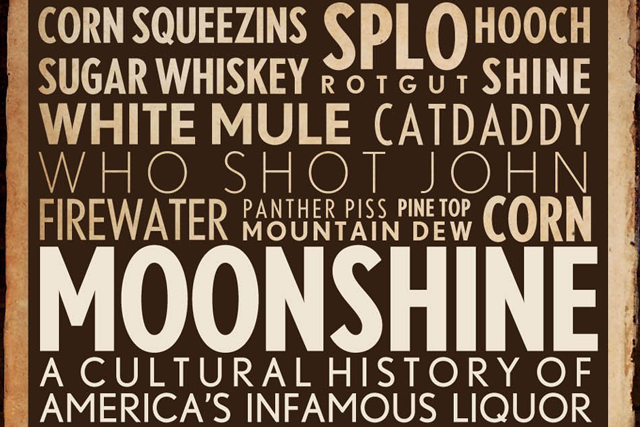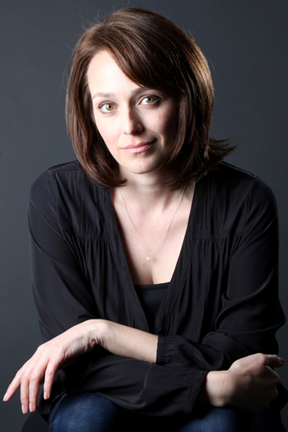The Flavorful Bookshelf: Jaime Joyce On Moonshine
By Melissa McEwen in Food on Aug 28, 2014 4:00PM

The body was found in a bog in La Grange in 1923. He’d been out drinking moonshine shots with friends in a local saloon. The saloon’s owner, Polish immigrant “Moonshine Mary” Wazeniak, ended up becoming the first woman sentenced under Illinois state law for selling poisoned liquor. The moonshine that landed the unlucky man in the bog had been laced with deadly wood alcohol.
It’s one of many stories of moonshine’s long Chicago history featured in Moonshine by Jaime Joyce. Moonshine tends to be associated with the backwoods mountain regions of the South, but the truth is it’s everywhere and has been as long as the government first decided to use distilling to raise revenue and ostensibly curb drunkenness in the late 1700s, sparking the Whiskey Rebellion. That rebellion was quashed, but smaller rebellions of simply distilling and selling illegal booze have continued ever since, especially under even harsher laws like Prohibition.
Joyce says “Chicago clearly has a long-storied liquor tradition. Moonshiners were very active in Prohibition. People think of the South when they hear moonshine and the South was a big driver of moonshining. But it happened in cities across the country and Chicago was one of them. There was a big bust associated with Al Capone, and there were people all over Chicago making it in basements and tenement houses. In one Al Capone bust they confiscated over 10,000 gallons of illicit alcohol. The thing with the Al Capone bust is gangs were bringing in people from Sicily specifically to make liquor. It was a big source of income for these immigrants.”
For many of these people, some of them women, it was a source of empowerment, a way to support their families. “(Moonshine Mary) was supporting herself and supporting her family. It involved big crime families, but also small operations that put food on the table. And there was a market for it. “

Author Jaime Joyce
Despite irking some traditional whiskey purists, since it hasn’t been aged in a barrel, some of these white whiskey “moonshines” are pretty damn good. I thoroughly enjoyed the Two James Rye Dog I tried at the NRA Show this year. Joyce recommends Troy & Sons from North Carolina. Joyce says it’s also a product that allows new small distilleries to get their feet in the door “For example Death’s Door Distillery in Wisconsin– the distributor wanted a whiskey, but didn’t have the time or money to make whiskey, they made an unaged whiskey instead and it sold out.”
Other makers of “legal moonshine” claim the moniker through a history of actual illegal moonshine production, such as Clyde May’s, whose namesake served an 18-month sentence for illegal distilling in 1973. His now-legal Conecuh Ridge Alabama Fine Whiskey differs from white whiskey “moonshines” in that it has been aged in a barrel. Dwight Bearden, head whiskey maker at Dawsonville Moonshine Distillery, learned how to make moonshine the illegal way. Now their legal distillery draws tourists to their town, which claims to be the “Moonshine Capital Of The World.”
That might rub the some the wrong way, as there are as many places making moonshine as there are governments that regulate alcohol. Other illegal moonshining traditions have spawned legal offshoots such as Mexico’s increasingly popular Mezcal, which is sometimes called “Mexican Moonshine.”
Then there is the actual moonshine that’s still being made right in our city, often by city residents coming from cultures that have long moonshine traditions. I've had my share of pitorro, the Puerto Rican moonshine that’s deliciously “cured” with flavorings like coconut or passionfruit. Despite the dangerous reputation moonshine earned from sub-standard purveyors like Moonshine Mary, in modern times it’s unlikely to be any more dangerous than homemade pickles.
The Hobby Distiller’s Association’s FAQ says that most moonshine fears are unfounded, that they don’t have anything in common with Prohibition-era bootleggers intentionally distilling out of substandard materials and diluting with wood alcohol to make a quick buck.
Joyce says pretty much everyone who buys distilling equipment gets a nice letter from the Alcohol and Tobacco Tax and Trade Bureau warning them of the fines they may incur from their homemade whiskey. They are moonshiners whether they like it or not. And they don’t – the association aims to legalize home distilling the same way hobbyists legalized home beer brewing and wine-making.
But if there is anything to be learned from Joyce’s book, it’s that even if it never gets to be legal, people will make it anyway.